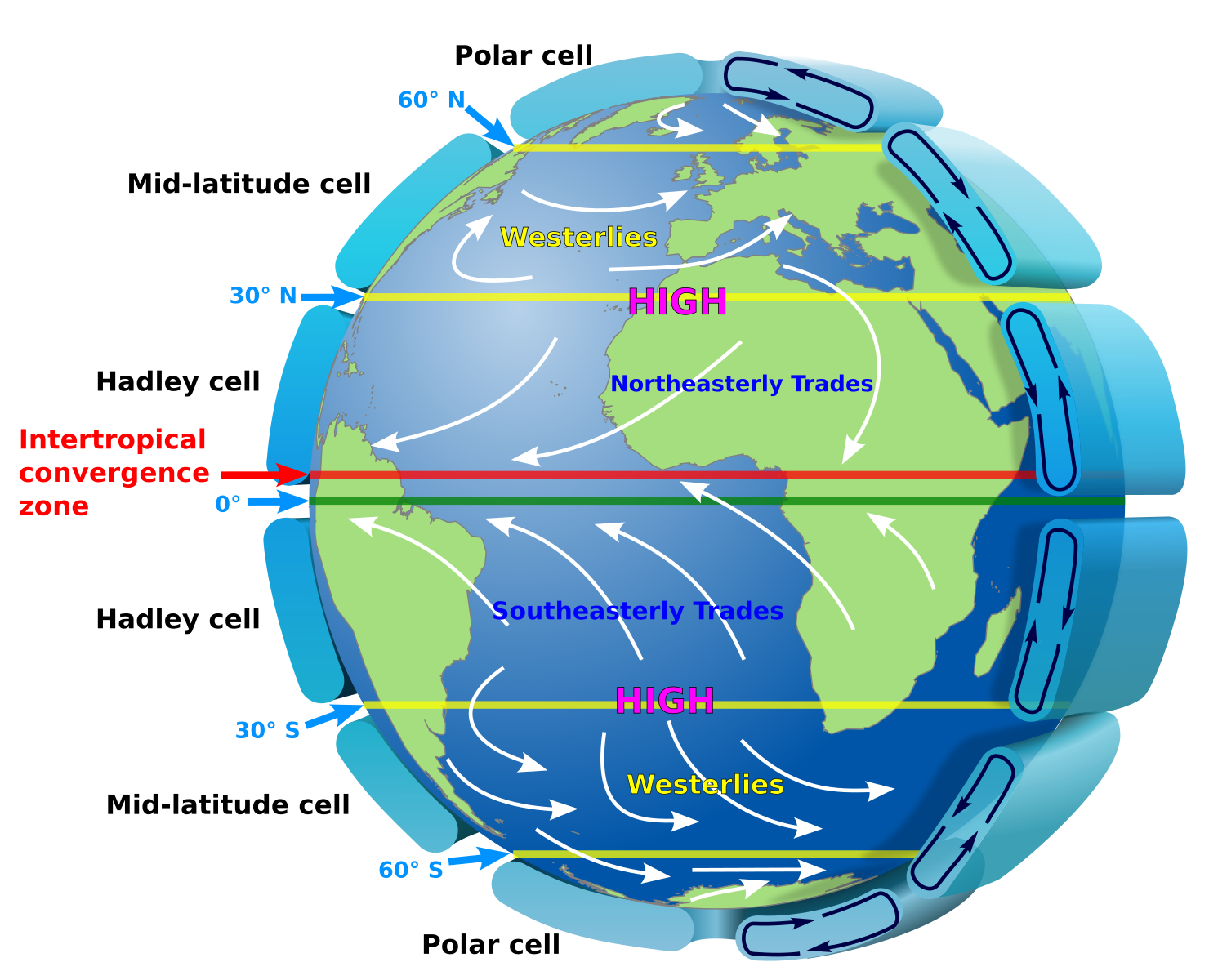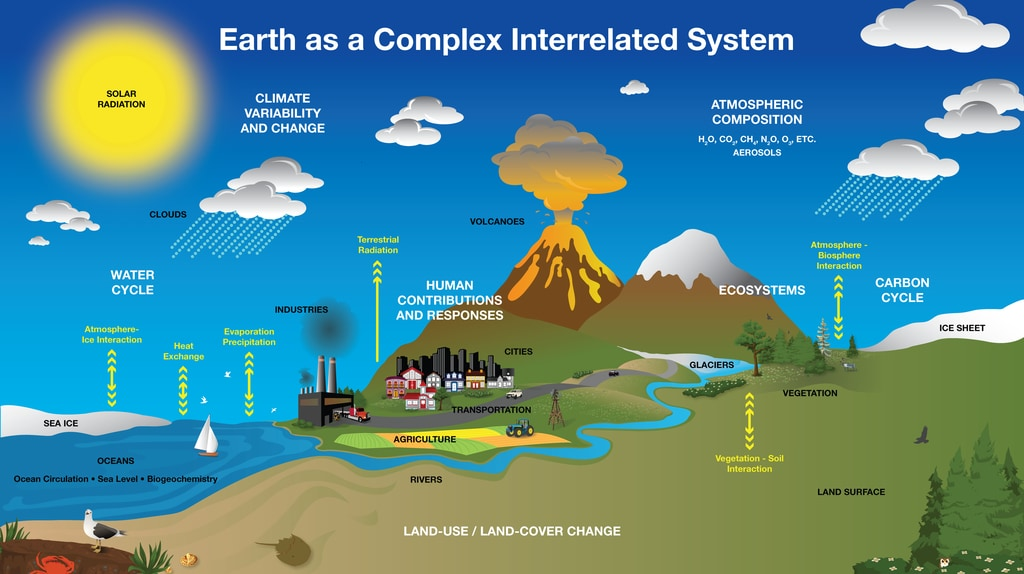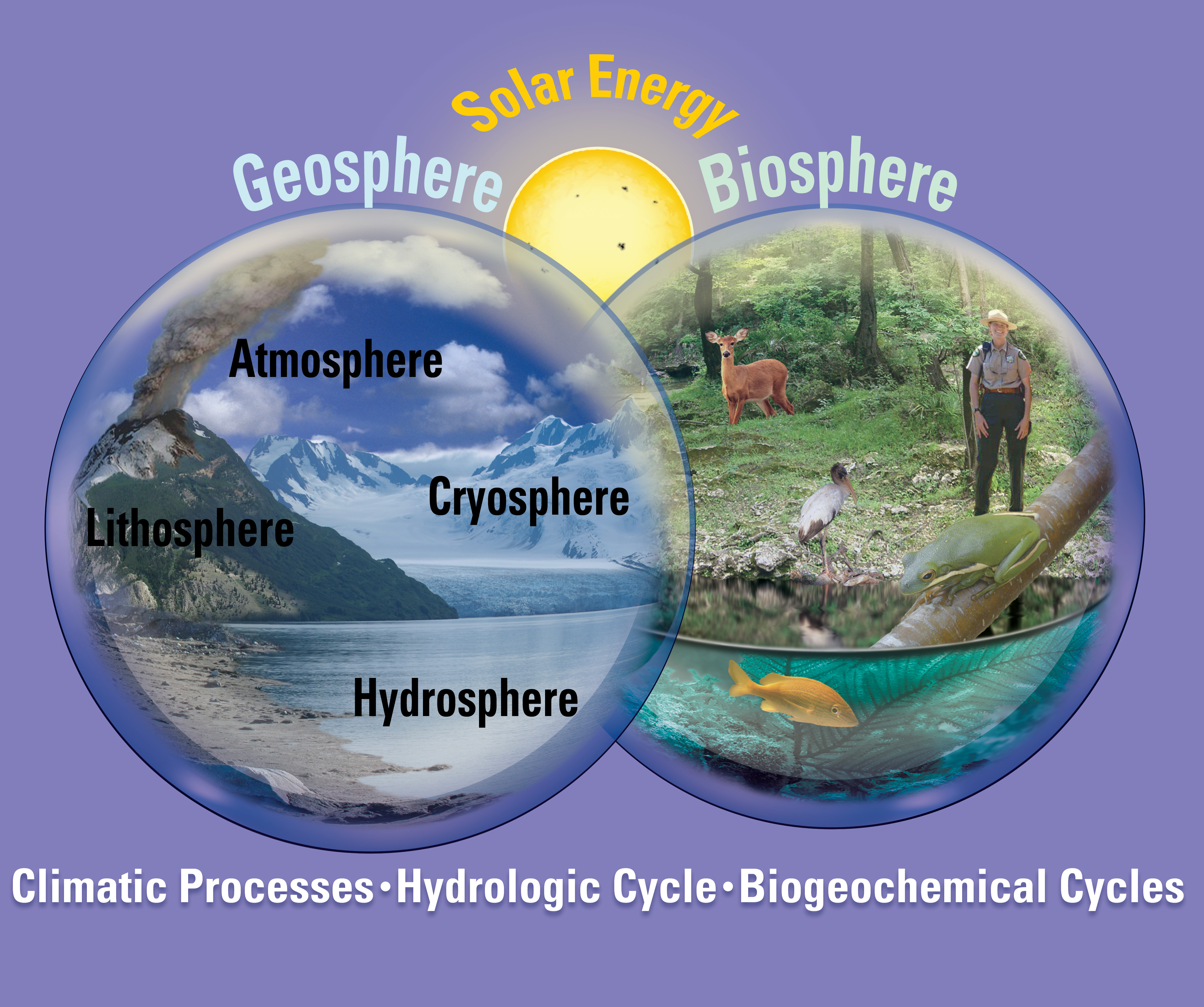IB Syllabus focus:
‘Earth functions as one system (biosphere, hydrosphere, cryosphere, geosphere, atmosphere, anthroposphere). Gaia models feedbacks stabilizing atmosphere and temperature. Systems operate from microhabitats to global circulation.’
Earth is best understood as a single, interconnected system. Multiple spheres interact continuously, with feedbacks stabilising global conditions and processes operating from tiny habitats to planetary circulation.
Earth as a Single System
The Earth system consists of interacting spheres that collectively regulate conditions suitable for life. These spheres are not isolated; instead, they are dynamic and interconnected.
Biosphere: All living organisms and their interactions with each other and the environment.
Hydrosphere: All forms of water, including oceans, lakes, rivers, and groundwater.
Cryosphere: All frozen water, such as glaciers, ice sheets, and permafrost.
Geosphere: Earth’s solid parts, including rocks, minerals, soils, and tectonic processes.
Atmosphere: The layers of gases surrounding Earth, regulating climate and protecting life.
Anthroposphere: Human-created systems, infrastructures, and activities that interact with natural processes.
Each sphere contributes to the functioning of the Earth system, creating complex feedback loops and dependencies.
The Gaia Hypothesis
The Gaia hypothesis, developed by James Lovelock, proposes that Earth behaves like a self-regulating organism.
Gaia Hypothesis: The idea that living organisms interact with their environment to maintain stable conditions, such as temperature and atmospheric composition, supporting life.
According to this model, feedback mechanisms link biological and physical processes. For example, vegetation influences atmospheric carbon dioxide, while ocean phytoplankton regulate atmospheric sulphur compounds.
This concept highlights the stabilising feedbacks that prevent extreme changes and maintain equilibrium, contributing to long-term habitability.
Feedbacks in Earth’s System
Feedbacks are crucial in explaining how Earth regulates itself.
Negative feedback: Dampens change and promotes stability.
Example: Increased atmospheric CO₂ enhances plant growth, which in turn absorbs more CO₂.
Positive feedback: Amplifies change and may push systems away from equilibrium.
Example: Melting ice reduces surface reflectivity (albedo), causing further warming and more ice melt.
The Gaia model emphasises how negative feedbacks help stabilise Earth’s climate and atmosphere over time.
Scales of Operation
Earth’s systems function across a wide range of spatial and temporal scales.
Microhabitats: Tiny systems such as soil microbe communities or ponds, showing localised cycles of matter and energy.
Regional ecosystems: Forests, rivers, and grasslands with complex food webs and nutrient cycles.
Global circulation systems: Large-scale atmospheric and oceanic currents, such as the Gulf Stream and the Hadley Cell, which distribute energy and regulate climate.

This schematic shows Earth’s general atmospheric circulation with the Hadley, Ferrel, and Polar cells and associated surface wind belts that redistribute heat globally. It visualises the large-scale processes referenced in the notes. Some map features (e.g., additional wind arrows) provide extra context beyond the syllabus. Source.
Processes at small scales often influence larger ones. For instance, microbial activity in soils affects carbon storage, which contributes to global atmospheric carbon levels.
Spheres and Their Interactions
Biosphere and Atmosphere
Plants exchange oxygen and carbon dioxide with the atmosphere.
Large-scale deforestation reduces the atmosphere’s capacity to absorb CO₂, intensifying climate change.
Hydrosphere and Cryosphere
Melting glaciers feed rivers and oceans, affecting freshwater availability.
Ocean circulation is influenced by salinity and temperature changes due to melting ice.
Geosphere and Atmosphere
Volcanic eruptions release gases and ash, altering climate conditions temporarily.
Weathering of rocks captures CO₂, providing a long-term stabilising effect.
Anthroposphere and All Other Spheres
Human activities such as fossil fuel burning impact atmospheric greenhouse gas concentrations.
Infrastructure, agriculture, and urbanisation alter ecosystems, influencing both biosphere and hydrosphere.
These interactions show Earth as a complex adaptive system, where actions in one sphere ripple across others.

This labelled systems diagram visualises how Earth’s spheres interact—linking atmosphere, oceans, ice, land, ecosystems, and human activity into a single, integrated system. It highlights energy and matter pathways that underpin stabilising feedbacks discussed in the syllabus. Some process labels (for example, “biogeochemistry”) extend slightly beyond the syllabus detail. Source.
Energy Flows and Matter Cycles
Energy enters the Earth system primarily from the Sun. It drives photosynthesis, atmospheric circulation, and ocean currents. Meanwhile, matter cycles—such as the carbon, nitrogen, and water cycles—circulate resources between the spheres.

This conceptual diagram places Earth’s spheres together and highlights solar energy as the driver of climatic, hydrologic, and biogeochemical processes. It reinforces how the spheres co-function within a single Earth system. The figure does not explicitly label an “anthroposphere,” which is covered in the notes and the NASA diagram. Source.
Carbon Cycle: The movement of carbon among atmosphere, biosphere, hydrosphere, and geosphere through processes like photosynthesis, respiration, decomposition, and combustion.
These flows ensure the functioning of ecosystems and regulate climate. Disruptions, especially from human activity, can destabilise the system.
Importance of Viewing Earth as an Integrated System
Seeing Earth as one integrated system allows us to:
Understand how local changes can scale up to global impacts.
Recognise the importance of feedback loops in maintaining stability.
Acknowledge the influence of the anthroposphere on long-term planetary health.
Appreciate the role of resilience, or the system’s ability to recover from disturbances.
The IB syllabus emphasises this integrated perspective to highlight the interdependence of ecological, physical, and human processes in shaping the planet’s future.
FAQ
The anthroposphere refers specifically to human-created systems, such as cities, agriculture, and infrastructure. Unlike natural spheres, it represents intentional human alteration of the environment.
It interacts continuously with other spheres—for example:
Emissions from industry affecting the atmosphere
Dams and irrigation systems altering the hydrosphere
Urban expansion reducing habitats in the biosphere
The cryosphere has high albedo, meaning it reflects a large proportion of incoming solar radiation. This helps moderate global temperatures.
When ice melts, reflectivity decreases, leading to more heat absorption by land and oceans. This process contributes to positive feedback, amplifying warming trends.
Microhabitats, such as soil pockets or tree canopies, are small-scale systems that recycle nutrients and regulate local energy flows.
Their role is significant because:
Microbial processes influence larger cycles, such as carbon and nitrogen.
Local diversity enhances resilience against disturbances.
Small-scale changes accumulate to affect regional and global systems.
Volcanoes release gases and ash into the atmosphere, influencing climate and air quality.
Sulphur dioxide forms aerosols that reflect sunlight, temporarily cooling the Earth.
Carbon dioxide released adds to greenhouse gas levels, affecting long-term warming.
Ash deposits alter soils, impacting the biosphere and agriculture.
Solar energy powers processes across all spheres:
It drives photosynthesis in the biosphere.
It fuels atmospheric and oceanic circulation.
It regulates cryosphere dynamics by influencing melting and freezing cycles.
It powers the hydrological cycle by evaporating water.
Without solar input, energy flows and matter cycles essential to system stability would collapse.
Practice Questions
Question 1 (2 marks)
Identify two Earth spheres, other than the biosphere, and briefly describe how each interacts with the biosphere.
Mark Scheme:
1 mark for identifying a relevant sphere (hydrosphere, cryosphere, geosphere, atmosphere, anthroposphere).
1 mark for a brief but correct description of the interaction (e.g., hydrosphere provides water for plant growth; atmosphere supplies CO₂ for photosynthesis).
(Maximum 2 marks)
Question 2 (5 marks)
Explain how feedback mechanisms within the Earth system help to stabilise global conditions, using one specific example.
Mark Scheme:
1 mark for defining feedback in the context of Earth systems.
1 mark for distinguishing between positive and negative feedback.
2 marks for a clear description of a specific example (e.g., increased CO₂ stimulating plant growth which absorbs CO₂).
1 mark for explaining how this process contributes to the stabilisation of global conditions.
(Maximum 5 marks)

